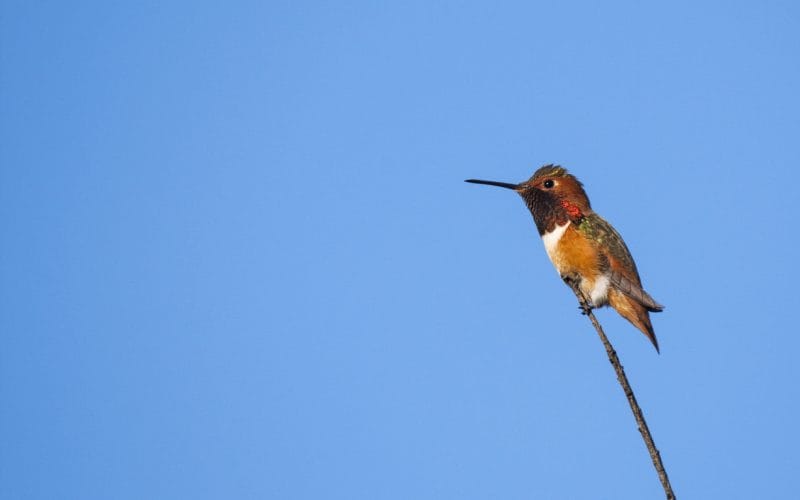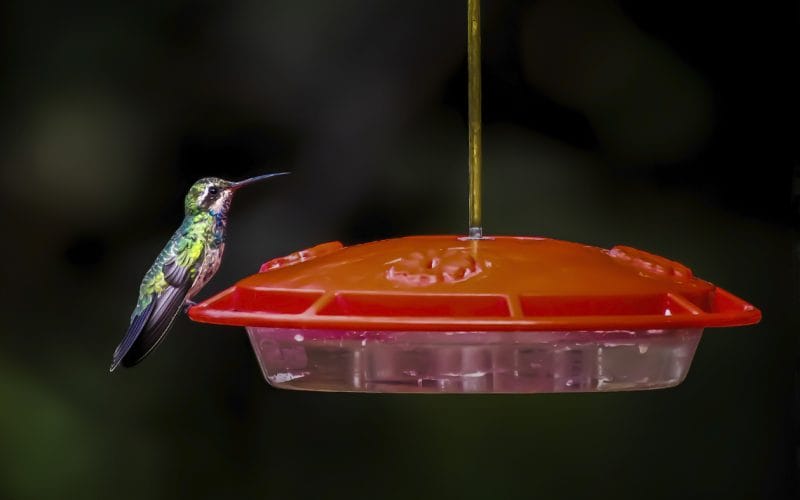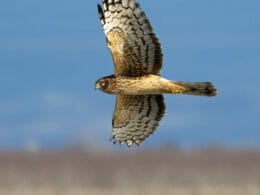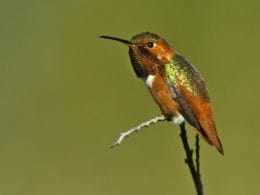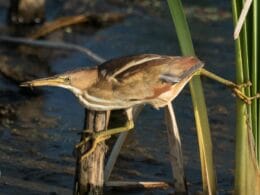If you’re interested in bird watching, Texas should be on your must-visit list of states.
As of December 2021, the Texas Bird Records Committee approved an official list of bird species that named a whopping 657 species found across the Lone Star State.
Out of this massive range of birds, you can spot 19 species of hummingbirds in Texas. Today, we’re sharing interesting facts and information about these beauties.
19 Gorgeous Hummingbirds in Texas
The following are 19 fascinating hummingbirds that you can look out for throughout Texas:
1. Rivoli’s Hummingbird
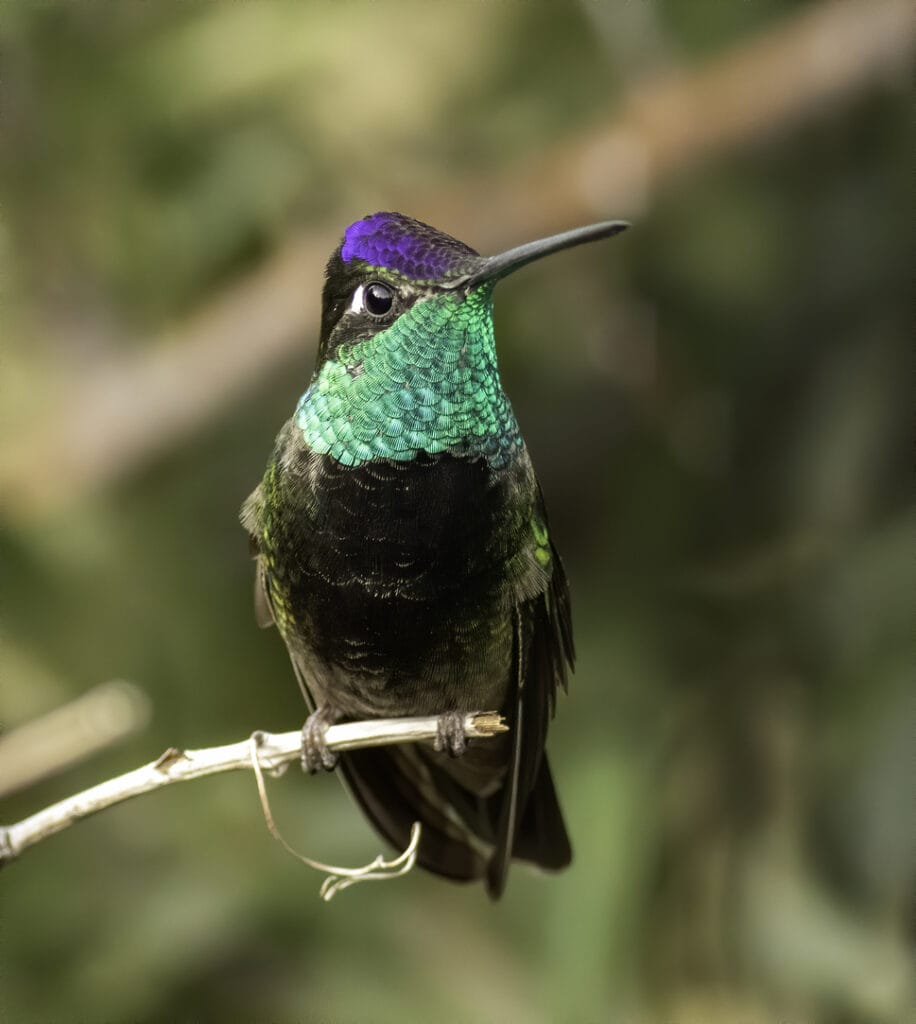
- Scientific name: Eugenes fulgens
- Length: 4.3 to 5.5 inches (11 to 14 cm)
- Weight: 0.2 to 0.3 ounces (7 to 8 g)
- Wingspan: 7.1 inches (18 cm)
A relatively large hummingbird, the Rivoli’s Hummingbird male population shows off emerald green throats and purple caps.
Author Note: Females of the species have greenish backs and heads with grey undersides. Behind their pitch-black eyes, both sexes show a white spot.
These birds prefer to stay around mountainous regions close to creeks and streams. Their diet includes nectar and insects, whereas their feeding strategy is trap-lining.
2. Blue-throated Mountain-gem

- Scientific name: Lampornis clemenciae
- Length: 4.3 to 4.7 inches (11 to 12 cm)
- Weight: 0.25 to 0.3 ounces (8.1 to 8.6 g)
- Wingspan: 3.1 inches (7.9 cm) for males and 2.3 inches (6.9 cm) for females
Another relatively large species, the Blue-throated Mountain-gem (also called Blue-throated Hummingbird) typically stays in mixed and coniferous woodlands near creek beds where a lot of flowers reside.
They’re also frequent visitors of feeders, but they tend to bully smaller birds to stay away. They also munch on insects from plants.
Males of the species are dull green on top with an iridescent blue throat. Females don’t have a colored throat.
3. Lucifer Hummingbird

- Scientific name: Calothorax lucifer
- Length: 3.5 inches (8.9 cm)
- Weight: 0.1 to 0.14 ounces (3 to 4 g)
- Wingspan: 4 inches (10 cm)
The Lucifer Hummingbird has a slim forked tail that’s significantly longer than its wings and a characteristically curved beak.
The males possess a bright royal purple throat that shimmers in the light. They’re greenish above and greyish below. The females have buff undersides without the purple gorget.
Author Note: The Lucifer Hummingbird is mostly present in Texas during the spring and summer, particularly in the Davis Mountains and the Big Bend National Park.
4. Ruby-throated Hummingbird

- Scientific name: Archilochus colubris
- Length: 2.8 to 3.5 inches (7 to 9 cm)
- Weight: 0.1 to 0.2 ounces (2 to 6 g)
- Wingspan: 3.1 to 4.3 inches (8 to 11 cm)
On the smaller side, we have the Ruby-throated Hummingbird with its distinct reddish-orange throat displayed on the males when in good light.
Both sexes are glittery green on top with buff-colored undersides. Their wings are quite short and their beaks are a tad down curved.
These small birds are found in Texas from early spring to early fall, especially common in Houston, Austin, and Dallas.
5. Black-chinned Hummingbird
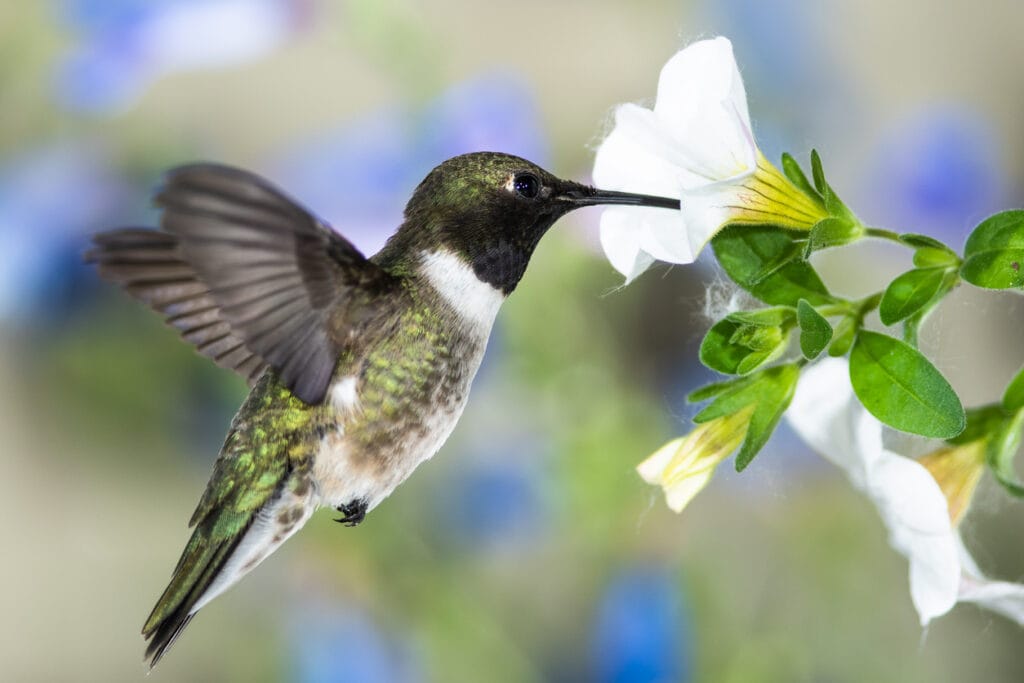
- Scientific name: Archilochus alexandri
- Length: 3.5 inches (9 cm)
- Weight: 0.1 to 0.2 ounces (2.3 to 4.9 g)
- Wingspan: 4.3 inches (11 cm)
Present across western and central areas of Texas, the Black-chinned Hummingbird has a slim body with an almost straight beak. It’s about the same size as the Ruby-throated Hummingbird.
Color-wise, both sexes possess a metallic green cap and back with whitish undersides. In males, the throat is black with a purple band at the base.
Black-chinned Hummingbirds love to visit feeders and are attracted to vibrant native flowers.
6. Anna’s Hummingbird
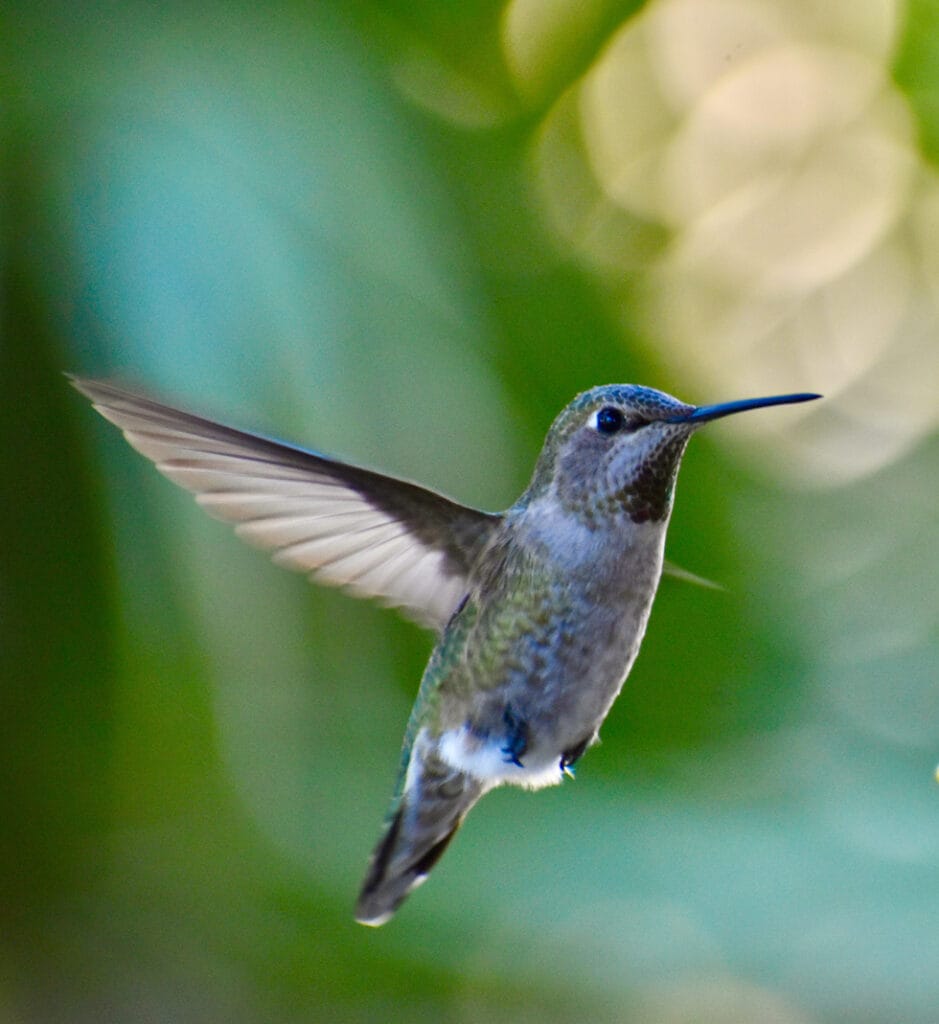
- Scientific name: Calypte anna
- Length: 3.9 inches (10 cm)
- Weight: 0.1 to 0.2 ounces (3 to 6 g)
- Wingspan: 4.7 inches (12 cm)
Unlike many other hummingbirds, you can commonly spot this species in Texas during the winter months throughout western and northwestern regions.
Anna’s Hummingbird has a stocky body with a relatively wide tail and short beak. Its plumage consists of shades of green and grey, but the males also possess hot pink patches on their throats and heads.
7. Calliope Hummingbird

- Scientific name: Selasphorus calliope
- Length: 3.1 to 3.5 inches (8 to 9 cm)
- Weight: 0.08 to 0.12 ounces (2.3 to 3.4 g)
- Wingspan: 4.1 to 4.3 inches (10.5 to 11 cm)
During their migration in the fall, you can easily spot the Calliope Hummingbird in western regions of the Lone Star State such as El Pasi and the Big Bend National Park.
This species is one of the easiest to identify and also one of the smallest on today’s list. It has short wings, a short tail, and a short bill.
Top Tip: The male has characteristic magenta-colored lines radiating across his throat. Both sexes are green and gold on top with pale grey undersides.
8. Rufous Hummingbird
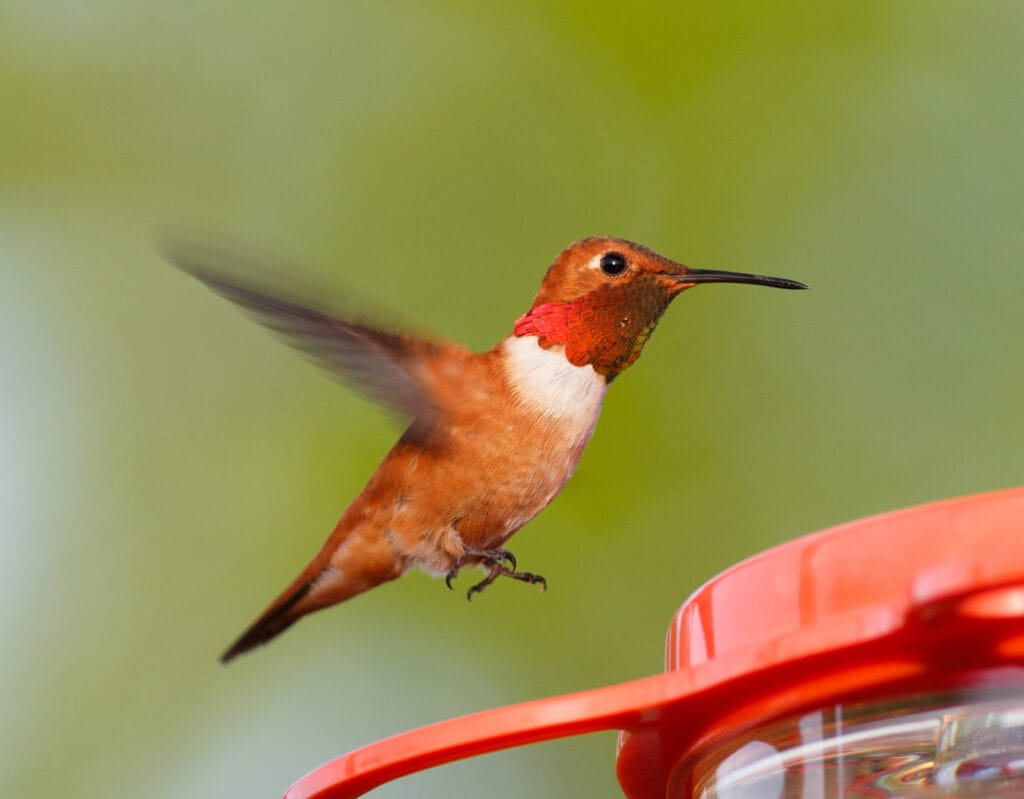
- Scientific name: Selasphorus rufus
- Length: 2.8 to 3.5 inches (7 to 9 cm)
- Weight: 0.1 to 0.2 ounces (2 to 5 g)
- Wingspan: 4.3 inches (11 cm)
Another relatively tiny species you can spot in Texas is the Rufous Hummingbird with its tapered tail and straight beak.
The males feature a magnificent orange copper plumage and an iridescent orange throat, while the females have the color only on their flanks. Both sexes have green on their backs.
The Rufous Hummingbird is mostly seen during the fall across the western part of the state.
9. Allen’s Hummingbird

- Scientific name: Selasphorus sasin
- Length: 3.5 in (9 cm)
- Weight: 0.07 to 0.14 ounces (2 to 4 g)
- Wingspan: 4.3 inches (11 cm)
January and February are the best times to spot Allen’s Hummingbird in Texas.
They do appear pretty similar to Rufous Hummingbirds since their males possess vibrant orange throats and a coppery green body.
10. Broad-tailed Hummingbird
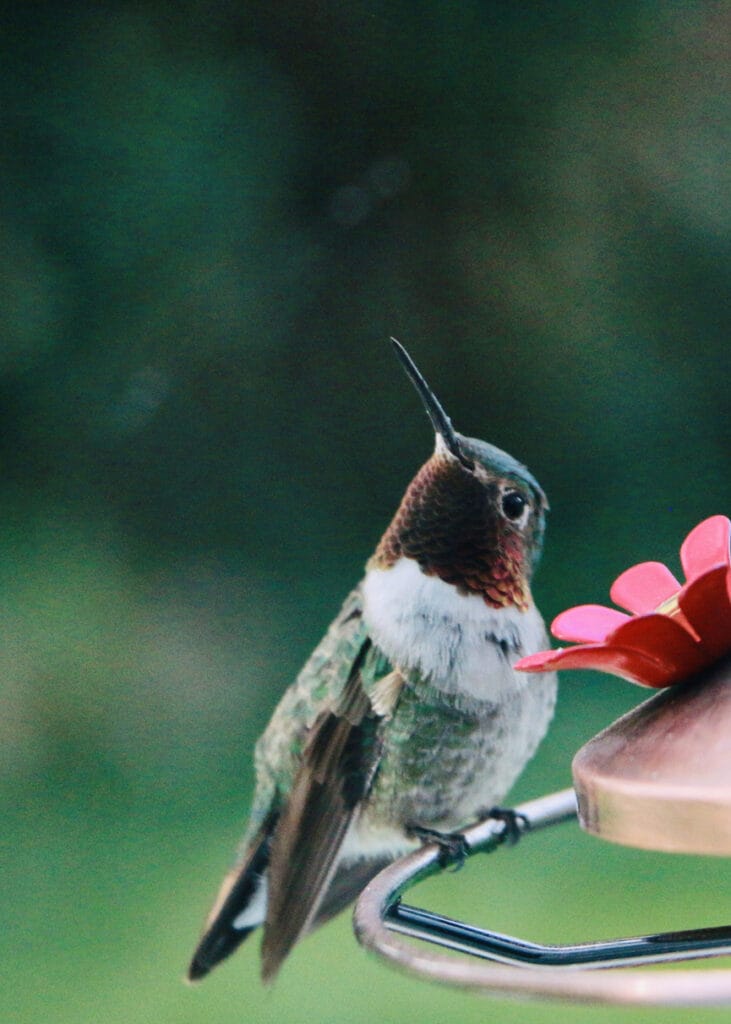
- Scientific name: Selasphorus platycercus
- Length: 3.1 to 3.5 inches (8 to 9 cm)
- Weight: 0.1 to 0.2 ounces (2.8 to 4.5 g)
- Wingspan: 5.25 inches (13 cm)
Once again, the Big Bend National Park and El Paso are among the best places to spot the Broad-tailed Hummingbird. Medium-sized for a hummingbird, this species has a big head, a puffy body, and a long beak.
The males possess a unique light magenta throat, while both sexes are bright green on top and buffy green below. These birds like staying in high points around evergreen and pine-oak forests.
11. Broad-billed Hummingbird

- Scientific name: Cynanthus latirostris
- Length: 3.1 to 3.9 inches (8 to 10 cm)
- Weight: 0.07 to 0.14 ounces (2 to 4 g)
- Wingspan: 5.1 inches (13 cm)
The Broad-billed Hummingbird isn’t a common sight in Texas, but it’s been increasingly reported in recent years in the Davis Mountains area. This species has a small body with a long notched tail and a straight beak.
Author Note: Males are a glittery green and blue color all over. They also have bright red bills with a black tip. Females are grey, green, and buff. They possess a white stripe behind their eyes.
12. Buff-bellied Hummingbird
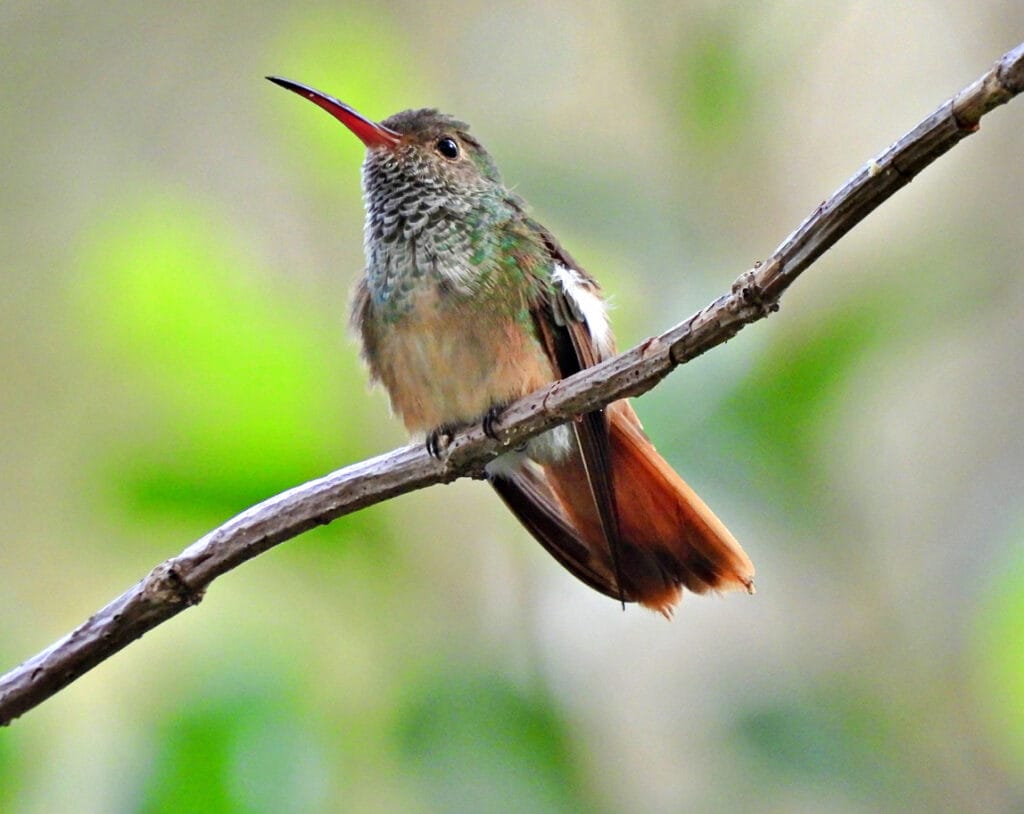
- Scientific name: Amazilia yucatanensis
- Length: 3.9 to 4.3 inches (10 to 11 cm)
- Weight: 0.07 to 0.14 ounces (2 to 4 g)
- Wingspan: 5.75 inches (14.6 cm)
Buff-bellied Hummingbirds are one of the relatively largest species of hummingbirds you can see in the United States.
Their bodies are greenish copper and their beaks are red with a black tip. They also possess an iridescent green-blue throat with a rich buff belly.
13. Mexican Violetear
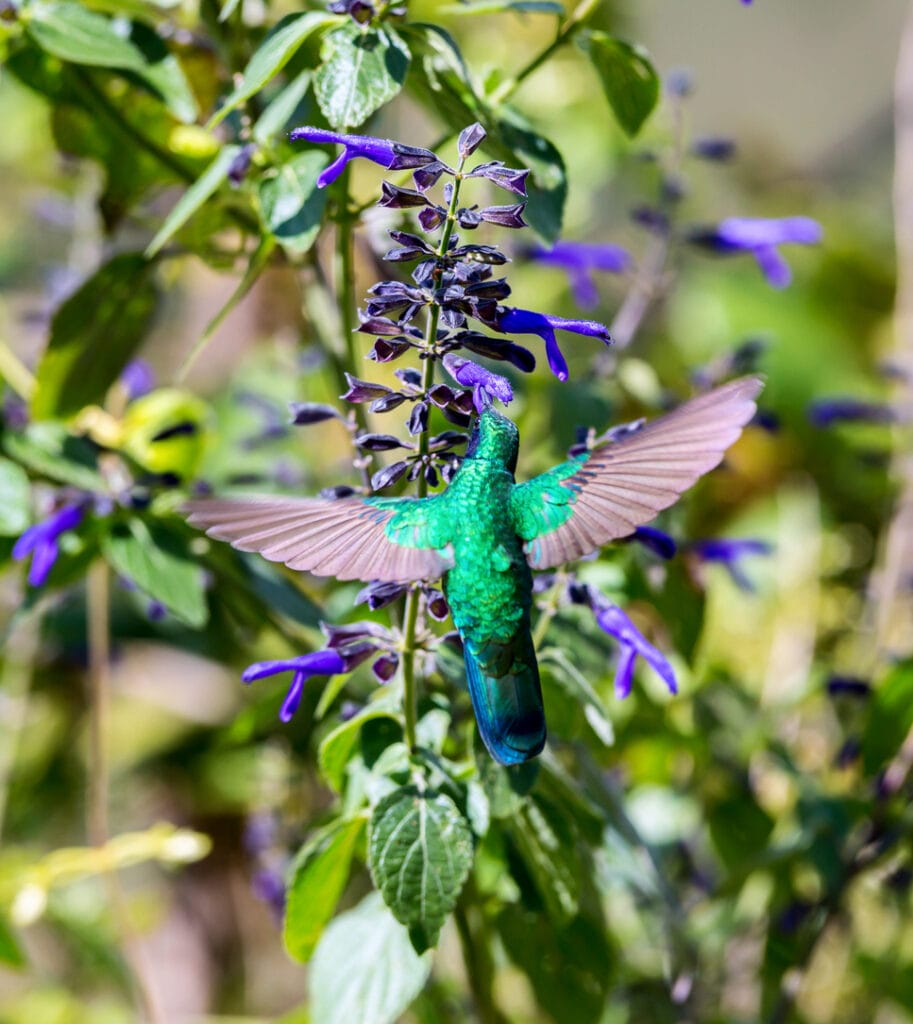
- Scientific name: Colibri thalassinus
- Length: 3.8 to 4.7 inches (9.7 to 12 cm)
- Weight: 0.17 to 0.2 ounces (4.8 to 5.6 g)
- Wingspan: 7 inches (17.8 cm)
Also known as the Green Violetear, the Mexican Violetear is a medium-sized hummingbird that’s somewhat rare to spot in Texas. You can, however, see it in the southern and central areas of the state during the non-breeding season.
This species sports a metallic green plumage with blue patches on their chests and each side of their heads.
14. Green-breasted Mango
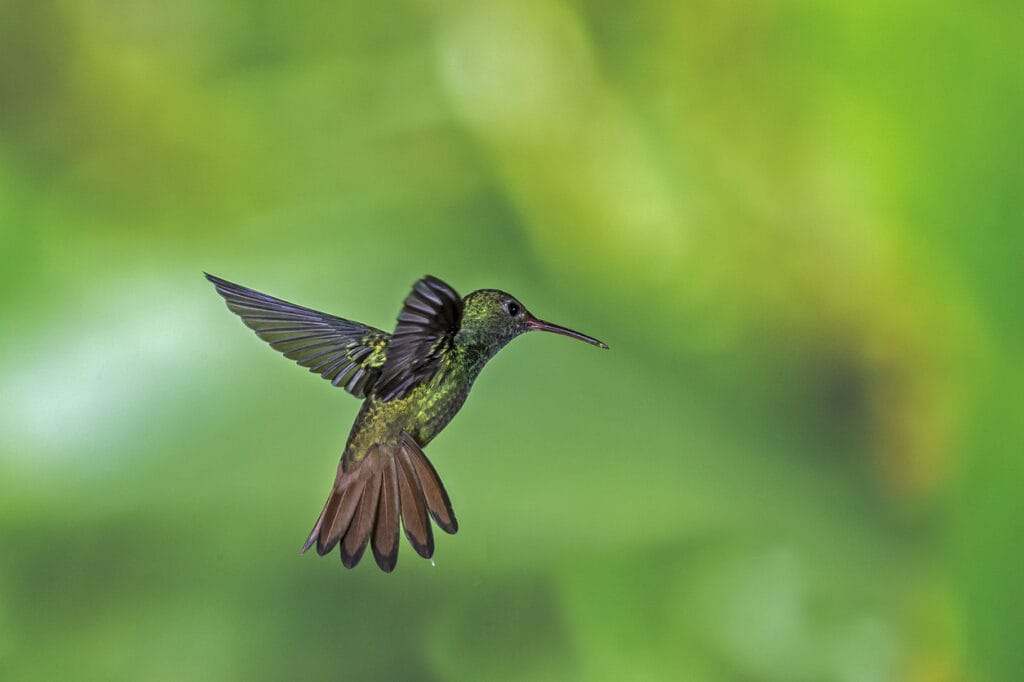
- Scientific name: Anthracothorax prevostii
- Length: 4.3 to 4.7 inches ( 11 to 12 cm)
- Weight: 0.24 to 0.25 ounces (6.8 to 7.2 g)
- Wingspan: 5 to 6 inches (13 to15 cm)
Another rare hummingbird to spot in the Lone Star State is the Green-breasted Mango.
These birds live in tropical regions around Central America and Mexico, consequently, the southeastern border between Texas and Mexico can be a good place to see them.
Author Note: True to its name, the Green-breasted Mango sports a shimmery green coat on top. Males have blue undersides while females possess white breasts with a black line in the center.
15. Amethyst-throated Mountain-gem

- Scientific name: Lampornis amethystinus
- Length: 4.5 to 5 inches (11.5 to 12.5 cm)
- Weight: 0.14 to 0.2 ounces (4 to 6 g)
- Wingspan: —
This large hummingbird looks similar to the Blue-throated Mountain-gem. It’s not a common sighting in Texas as they prefer tropical forests of Central America such as in El Salvador and Mexico.
The Males of the species possess glossy deep purple throats and white stripes behind each eye.
16. Costa’s Hummingbird

- Scientific name: Calypte costae
- Length: 3.5 inches ( 7.6 to 8.8 cm)
- Weight: 0.07 to 0.1 ounces (2 to 3 g)
- Wingspan: 4.3 inches (11 cm)
With compact bodies, short tails, and short wings, Costa’s Hummingbirds are no doubt cute. The males of the species have vibrant violet caps that flare out at the beginning of the breast, resembling a long mustache.
Top Tip: Your best chance of spotting this bird is at the Big Bend National Park or the southeastern Mexican border.
17. White-eared Hummingbird
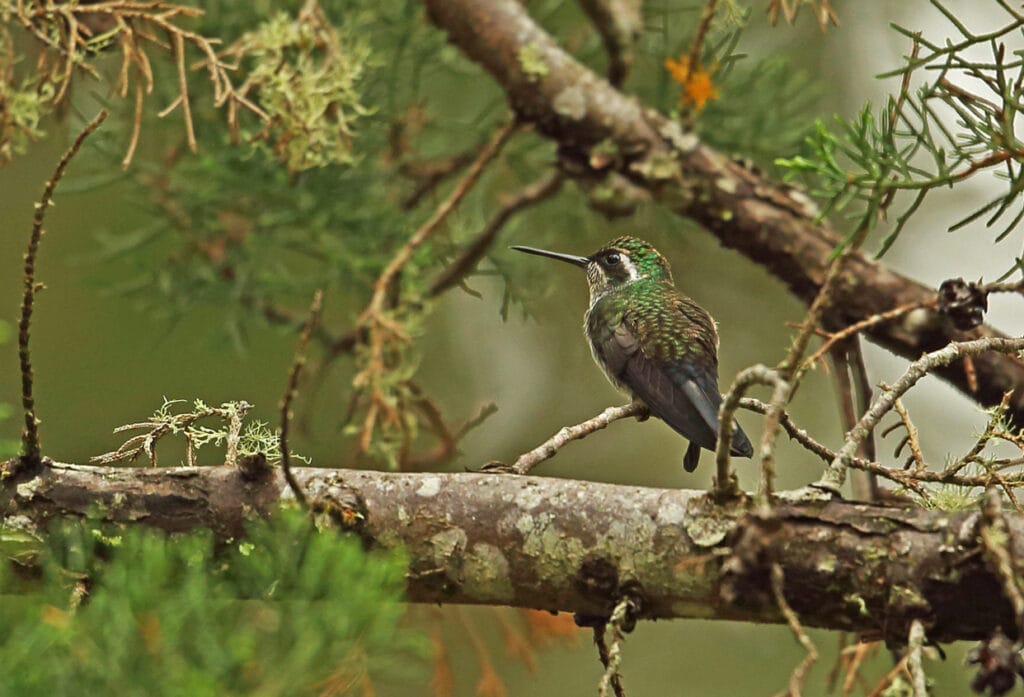
- Scientific name: Basilinna leucotis
- Length: 3.5 to 4 inches (9 to 10 cm)
- Weight: 0.1 to 0.14 ounces (3 to 4 g)
- Wingspan: 4 to 5 inches (10 to 13 cm)
This hummingbird gets its name from the bold white lines extending behind the eyes of both sexes. Their plumage features shades of green with a distinct turquoise throat patch in males.
Your best shot to spot the White-eared Hummingbird in Texas is during the summer around the Guadalupe mountains and in the Big Bend National Park.
18. Berylline Hummingbird
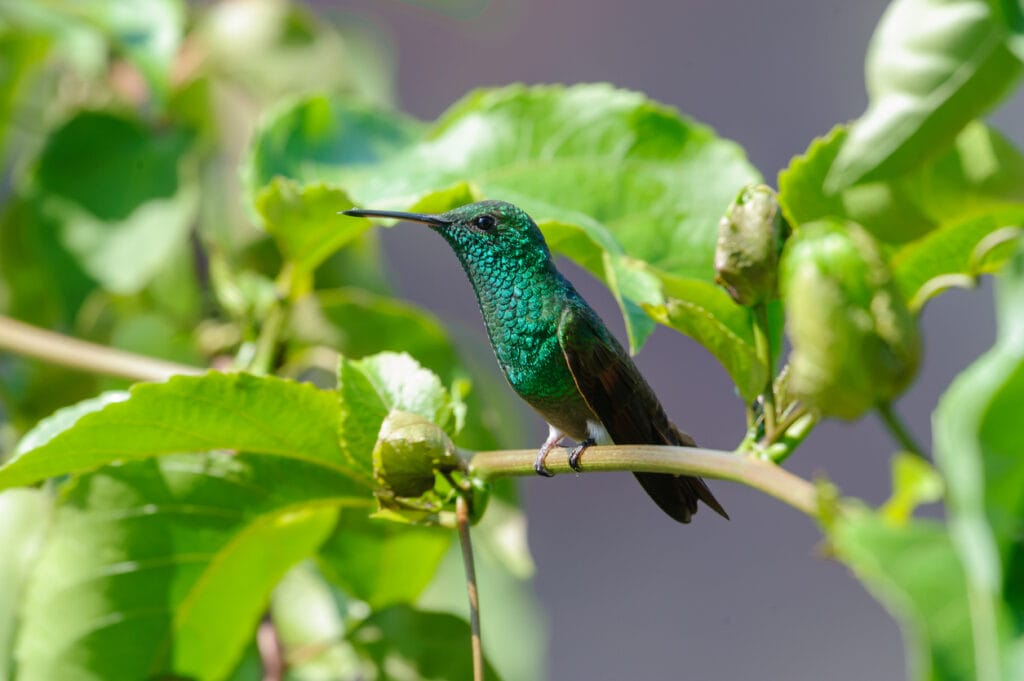
- Scientific name: Saucerottia beryllina
- Length: 3.9 to 5 inches (10 to 11 cm)
- Weight: 0.14 to 0.17 ounces (4 to 5 g)
- Wingspan: 5.75 inches (14.6 cm)
The Berylline Hummingbird’s name refers to a mineral called beryl, which exists in green varieties that look like the color of the bird.
The males of the species possess vibrant green caps and throats with a light brown underside and deep brown wings. Their tails and beaks are dark red with purple hues.
The first time this bird was seen in the United States was documented back in 1964. It’s on the rare side of sightings in Texas where it prefers staying in woodlands and deciduous forests.
19. Violet-crowned Hummingbird
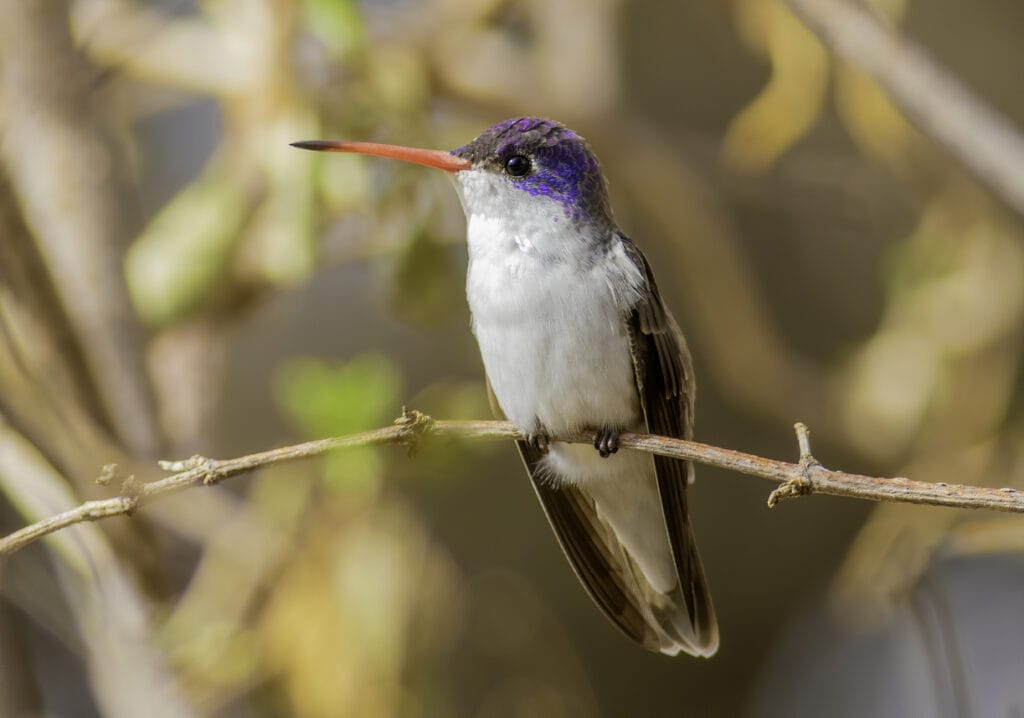
- Scientific name: Leucolia violiceps
- Length: 4.3 inches (11 cm)
- Weight: 0.16 to 0.2 oz (4.6-5.8 g)
- Wingspan: 5.9 inches (15 cm)
Last but not least, the Violet-crowned Hummingbird gets its name from the unique bluish-purple cap on the top of its head that looks like it’s wearing a violet crown. You’ll see a white patch behind its pitch-black eyes and a bright orange beak with a black tip.
This medium-sized bird has a dark olive back and wings with a snow-white underside. Females are a bit less vibrant than males.
You can find Violet-crowned Hummingbirds in riparian regions, meadows, and dry forests. They’re not a very common sight to behold in Texas, but they do make appearances throughout El Paso.
Top Tip: In addition to drinking nectar from flowers, these beauties also munch on flying insects and insects residing on plants.
Wrap Up
With so many stunning hummingbirds in Texas, it’s easy to see why the Lone Star State is a dream destination for bird-watching enthusiasts. We hope you enjoyed our guide on the most common hummingbirds in Texas.
FAQ
Laguna Atascosa National Wildlife Refuge, Santa Ana National Wildlife Refuge, Mitchell Lake Audubon Center, Lost Maples State Natural Area, Big Bend National Park are all recommended by Audubon as good places to see different species of hummingbird.
The Ruby-throated and Anna’s Hummingbirds are particularly common in Texas.
To find out where recent sightings of hummingbirds have been, try eBird. You can search for the latest sightings or particular species or what has been seen in a certain area.





